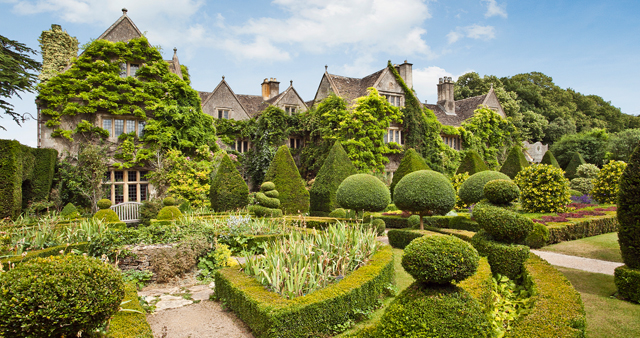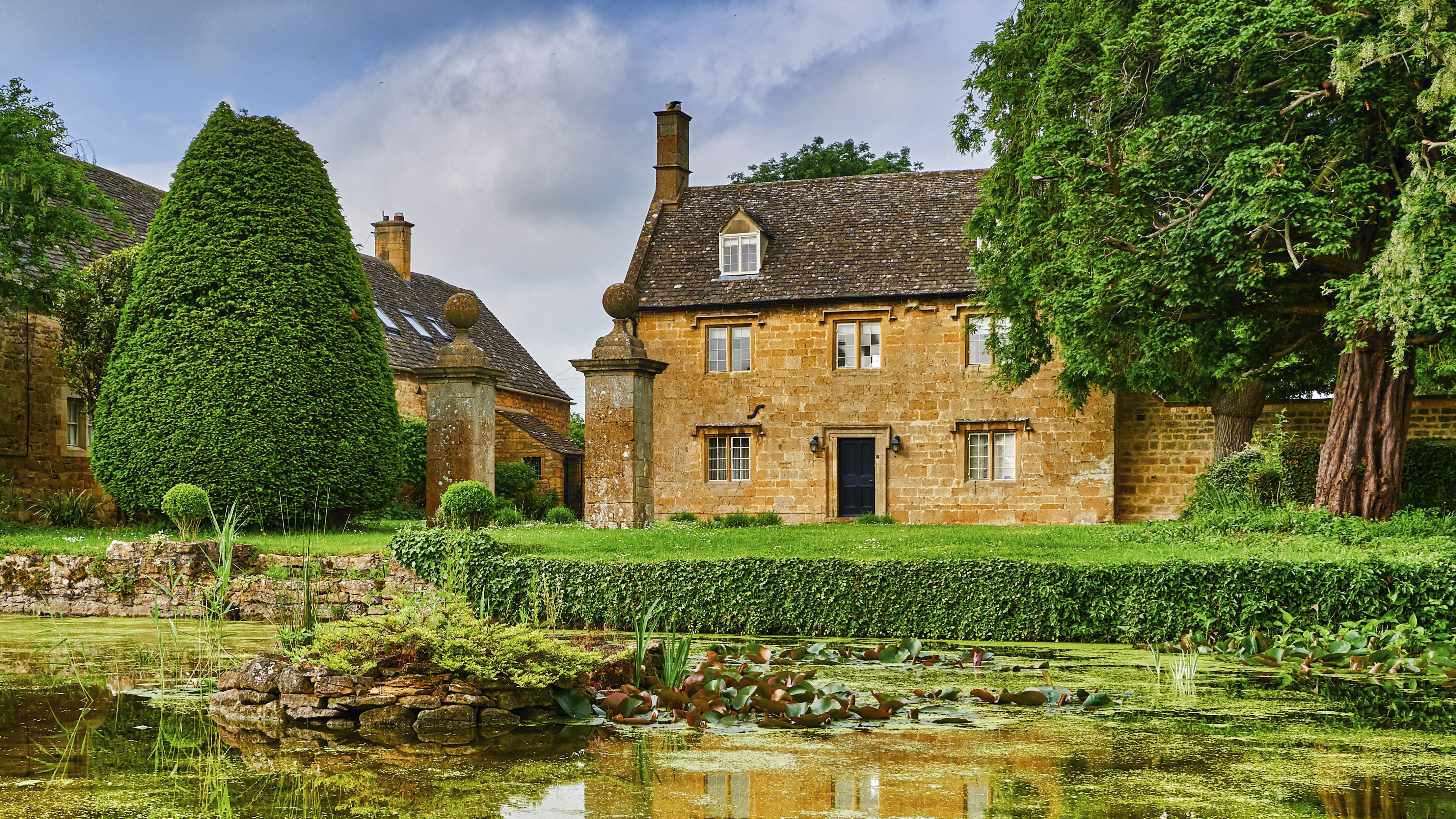Gardens of Eden
Two country houses in Wiltshire and Hampshire with exceptional gardens have come onto the market this September


Sales of historic country houses due to death, debt or divorce— the famous ‘three Ds’ that estate agents rely on to keep the market ticking over in difficult times—are always a source of local interest. But there was dismay among the business leaders of Malmesbury, Wiltshire, England’s oldest borough, when, in May, celebrity gardeners Ian and Barbara Pollard announced the sale—for £3.5 million through Strutt & Parker (01285 627550) and Savills (01285 653101) —of Grade I-listed Abbey House and its famous gardens in the heart of town, following the couple’s decision to call time on their 30-year partnership.
Abbey House and its 4. acres of grounds were in a state of neglect when, in 1994, Mr and Mrs Pollard bought the building in its wonderfully private setting overlooking the River Avon, next to the romantic, partly ruined, former Benedictine abbey where Aethelstan, the first king of all England, was buried in 939. The couple transformed the upper grounds around the house into a series of formal garden ‘rooms’ and the lower level, on either side of the river, into a picturesque wild garden interspersed with monastic fishponds, waterfalls and mill races. The gardens opened to the public in 1996, since when they have gained a coveted Michelin star.
But it was the couple’s appearance on BBC’s Gardeners’ World in June 2002 that highlighted their passion for naturism and catapulted the Pollards to international fame as the ‘Naked Gardeners’. They were even mentioned in the pages of Country Life. Naturists and tourists flocked to visit, especially on one of the regular ‘clothes optional’ days when they could throw caution, and clothes, to the wind and mingle among the flowers and foliage of Abbey House. If the end-of-season closure goes ahead as planned, the last ‘clothes optional’ day will be on Sunday, September 21, although it’s hoped that the next owner will continue to boost tourism in the town by keeping the gardens open to the public.

Of course, there is more to Abbey House than just the gardens. With 12,637sq ft of living space on four floors —including four reception rooms, 14 bedrooms and four bath/shower rooms (one unfinished)—and 800 years of history hanging in the air, this is a house that ‘takes a while to get your head around’, says Sam Trounson of Strutt & Parker, tactfully. After the Dissolution in 1539, Sir William Stumpe, a wealthy cloth merchant, bought the remains of Malmesbury Abbey from the Crown and gave the abbey, once the third most important religious centre in England after Canterbury and Winchester, back to the town. Either he, or his son Sir James, built Abbey House on the 13thcentury foundations of one of the former monastery buildings—possibly the Abbot’s house. The property was handed down through the Stumpe family, before passing by marriage to the Ivy family a century later.
In the 1920s, Capt Elliott Scott McKirdy commissioned the architect Harold Brakespear to extend the house, adding a nursery wing and servants’ quarters on the eastern side.
In 1968, The Deaconess Community of St Andrew bought the property and ran it as a religious centre and a home for elderly nuns until 1990, after which it remained unoccupied until the arrival of the Pollards four years later. Although short on bathrooms and with a layout that some might find confusing, Abbey House has some wonderful rooms and spaces, such as the panelled main reception hall, off which rises the principal staircase.
Also impressive is the library (previously two rooms), a splendid entertaining room with an impressive array of finely carved bookshelves. The oldest room is the Abbots Hall on the lower-ground floor, believed to have been built by Abbot William Colerne between 1260 and 1296. Older still is the large stone fireplace in the kitchen/ breakfast room, which is thought to have been built before 1260.
Exquisite houses, the beauty of Nature, and how to get the most from your life, straight to your inbox.

While the owners of Abbey House contemplate the end of their 20-year idyll on the banks of the Avon, the sale, for the first time in 55 years, of charming, 18th-century Chilton House at Chilton Candover, six miles from Alresford, Hampshire, is a rare opportunity for new owners to create their own private paradise on the banks of the Candover stream.
The name Candover means ‘clear waters’ and Chilton Candover is part of a Conservation Area covering three small villages, Brown Candover, Chilton Candover and Preston Candover, which have developed around medieval manor buildings and churches along the road that passes through the valley.
By coincidence, Sir James Stumpe sold the manor of Chilton Candover in 1562 to one John Fyssher, who is said to have, ‘depopulated this place, extirping the inhabitants, pulling down the howses… onlie remayneth the church and a ferme’ (Norden, 1595). The church was the old Church of St Nicholas, which was demolished in 1876, leaving only the graves and the tombstones.
The manor changed hands frequently between the 16th and 18th centuries and was owned by Lord Carteret from 1776 until his death in 1816, by which time Chilton House had been built as the village rectory. In 1818, Alexander Baring, later Lord Ashburton, bought the manor, which remained in his family until the 1930s.
Since then, with the exception of Chilton Manor, built in 1937, there has been almost no development at Chilton Candover since the late 1700s. Chilton House, listed Grade II, is for sale with more than 16 acres of gardens, paddocks and woodland, through Knight Frank in Winchester (01962 850333) at a guide price of £4m. Built of painted brickwork under a red clay-tile roof, it stands on a sweep of the main road, hidden by mature trees to the north and a tall brick-and-flint wall to the south.
With 8,000sq ft of living space, the house is roomy, elegant and easy to run, with four main reception rooms, a summer dining room, a games room, a kitchen/breakfast room, a large master suite, six further bedrooms, three further bathrooms and a separate two-bedroom cottage.
* Search country houses for sale
* Follow Country Life magazine on Twitter
-
 ‘Calf’s brains have a bland, gentle richness that soothes and cossets': Tom Parker Bowles on the joys of eating offal
‘Calf’s brains have a bland, gentle richness that soothes and cossets': Tom Parker Bowles on the joys of eating offalEating offal it is more sinned against than sinning, but it offers the ultimate in magnificent, fully immersive eating.
-
 The wave of downsizing about to hit the property market in the UK
The wave of downsizing about to hit the property market in the UKThe Chancellor of the Exchequer's Budget — and specifically the 'Mansion Tax' — has fired a starting pistol for downsizers, and the waves will wash across the entire property market. Annabel Dixon spoke to property experts across the country to gauge how it will play out.
